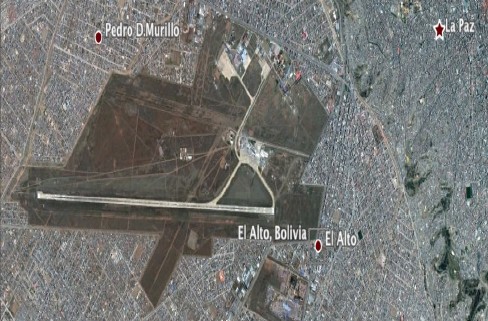
By Ruth Sabai
Water Politics in the El Alto Slum of Bolivia
The City of El Alto is located in Metro La Paz (Bolivia), with a 4% annual population growth rate (Arbona & Kohl, 2004). Urbanization in El Alto has been driven by periods of droughts and climate change, forcing rural farmers to migrate in search of income (Lazar, 2009). The twin cities in Metro La Paz, El Alto and La Paz account for 63% of the country’s population , El Alto has a relatively larger population of 962,097, compared to that in La Paz, with a population of 732,000 (Arbona & Kohl, 2004). Labor in both cities is dominated by the informal sector (ICFTU, 2005); however unlike El Alto, La Paz employees government workers and international development agencies, while El Alto houses the country’s manufacturing industries, an international airport, and the Pan American Highway , connecting to the Pacific Ocean (Arbona & Kohl, 2004). One of the major landscape transformations within Metro La Paz has been the expansion of gated communities in La Paz (UN-HABITAT, 2008) , a mix of high-income neighborhoods amidst lower-income areas, with unequal allocation of social services. The built environment of El Alto’s slum is reflective of the urban expansion from La Paz (Lanegran, 2011), causing a housing spread upward onto the sides of the valley, and into El Alto’s Altiplano, a high treeless plateau that stands at a height of 4000 meters above sea level (Arbona & Kohl, 2004). By location, the slum is at risk to natural hazards; additionally weak infrastructure prevents adequate provision of water and sanitation.
Access to Water and Sanitation
Slum dwellers experience multiple inequalities that are reflected in their living conditions , the lack of adequate housing, water, food, healthcare, education, insecure tenure, and unemployment; for instance 54% of Alte?±os depend on communal water points (Arbona & Kohl, 2004). There is little investment in water and sanitation services to El Alto’s slum , only 20% of the national budget is allocated to El Alto (Arbona & Kohl, 2004). Inclusion of slums in urban land-use is critical, in order to address the bigger structural constrains of the informal economy (Rudovsky et al., 2007). In Bolivia, 61% of the urban population lives in slums, and the slum child mortality rate is at 64%; it is higher than the non-slum child mortality rate at 46% (UN-HABITAT, 2004; UNHABITAT, 2012). Clean water is essential for reducing morbidity, and since most of the water contamination occurs during collection and storage, an area of intervention is hygiene with a focus on women and children (WCI, 2010). Another is through inhousehold water infrastructure development, which has previously improved community awareness (Caldera, 2001). Community participation is necessary in order to ensure long term improvements ‘ engagement through the Law of Popular Participation for local empowerment (Kolh, 2003). Finally large-scale inclusive environmental policies are needed, i.e. land and water management strategies.
Recommendations
Water politics are a big challenge in Bolivia. The inclusion of water and sanitation infrastructure, as well as aspects of water vulnerability in environmental adaptability strategies is needed. Additionally, connecting slum householders to piped water, drainage systems, garbed collection, and sewer treatments should involve multiple stakeholders.
This article is a product of Professor Shagun Mehrotra’s Global Urban Environmental Policy class. Views expressed are entirely those of the individual author.
References
Arbona, J., and Kohl, B. (2004). City Profile, El Alto-La Paz. Published by Elservier: Cities, Vol. 21, No. 3, p. 255’265. Retrieved in February 3rd 2012 from: http://www.temple.edu/gus/kohl/documents/lapazelaltocities.pdf
Caldera, A. (2001). El Alto Condominial Pilot Project Impact Assessment: A Summary. The Water & Sanitation Project. Published by the World Bank Office: Lima, Peru. Retrieved on February 4th 2011 from: http://www.wsp.org/wsp/sites/wsp.org/files/publications/2272007111637_elaltocondominalsumm.pdf
Google. (2012). Google Earth (Version 6.0.3.2197) [Software]. Available from http://www.earth.google.com
International Confederation of Free Trade Unions. (2005). Internationally-Recognised Cire Labor Standards in Bolivia. Published by International Confederation of Free Trade Unions (ICFTU). Report for the WTO General Council Review of the Trade Policies of Bolivia. Geneva, Switzerland. Accessed on
February 4th 2012, from: http://www.icftu.org/www/PDF/CLSBolivia.WTO.27-10-05.final.pdf
International Policy Center for Inclusive Growth. (2009). Water Privatisation and Renationalisation in Bolivia: Are the Poor Better Off?. Published by the International Policy Center for Inclusive Growth (IPCIG) under the United Nations Development Programme (UNDP): Brasilia, Brazil. Accessed on February 4th 2012, from: http://www.ipc-undp.org/pub/IPCOnePager100.pdf
Kolh, B. (2003). Democratizing Decentralization in Bolivia: The Law of Popular Participation. Publshed by Journal of Planning Education and Research 23:153-164. Retrieved on Februaty 5th 2011 from: http://www.temple.edu/gus/kohl/documents/LPPJPER03.pdf
Lanegran, D. (2011). Urban Structure: La Paz. Maclester College. St. Paul, MN. Accessed on February 4th 2012, from: http://www.macalester.edu/courses/geog61/amartin/urbanstruct.html
Lazar, S. (2009). El Alto, Rebel City: Self and Citizenship in Andean Bolivia. Published by Cornell University ILR School under the Industrial & Labor Relations Review, Vol. 62, No. 3: Ithaca, NY. Retrieved in February 3rd 2012 from: http://digitalcommons.ilr.cornell.edu/cgi/viewcontent.cgi?article=1707&context=ilrreview
Rudovsky, J.F, Gomes, Julie Lafreniere, J. (2007). Employment Insecurity in El Alto: Laboring to Survive. Tomorrow Crisis Today – The humanitarian impact of urbanization: Chapter 9, page 84-91. Published by the Integrated Regional Information Networks (IRIN), UN Office for the Coordination of Humanitarian
Affairs: New York, U.S.A. Retrieved on February 5th 2012 from: http://www.irinnews.org/pdf/indepth/TomorrowsCrisesToday-Chapter9.pdf
United Nations Human Settlements Programme (2004). Urban Health Inequalities: La Paz, Bolivia. Cities & Citizens Series. Published by the United Nations Human Settlements Programme (UN-HABITAT); Nairobi, Kenya. Accessed on February 4th 2012, from: http://www.unhabitat.org/downloads/docs/9176_38498_LaPazReport.pdf
United Nations Human Settlements Programme. (2012). Bolivia: Statistical Overview. (UN-HABITAT). Nairobi, Kenya. Accessed on February 2th 2012, from: http://www.unchs.org/categories.asp?catid=139
United Nations Human Settlements Programme. (2008). State of the World’s Cities 2008/2009 Harmonious Cities. Published by the United Nations Human Settlements Programme (UN-HABITAT): Nairobi, Kenya. Accessed on February 4th 2012, from: http://www.clc.org.sg/pdf/UNHABITAT%
20Report%20Overview.pdf
Women in Cities International (2010). Learning from Women to Create Gender Inclusive Cities: Baseline Findings from the Gender Inclusive Programme. Published by Women in Cities International (WCI): Montr?©al, Canada. Accessed on February 4th 2012, from: http://womenincities.org/pdfgeneral/
gicp_baseline.pdf